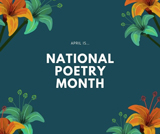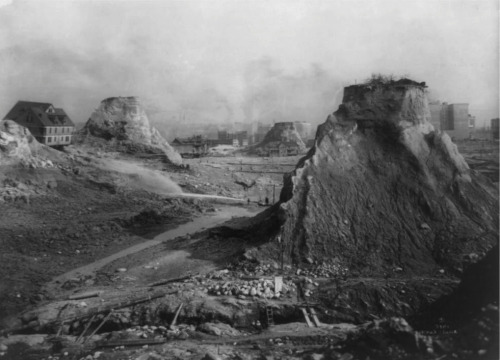 You’re probably familiar with this famous image of the historic Northwest. It depicts the last elevated redoubts of Denny Hill, which overlooked Seattle’s downtown business core until it was flattened in the name of progress in the early 20th century. I’ve always thought there was something noble about these holdout property owners, Edith Macefields avant la lettre, who resisted the steam shovels as long as they could from atop their so-called “spite mounds.” I was quite wrong about what I was seeing in the picture, as I realize now. As always, it took a book to help me understand what really happened (and continues to happen) right under my nose.
You’re probably familiar with this famous image of the historic Northwest. It depicts the last elevated redoubts of Denny Hill, which overlooked Seattle’s downtown business core until it was flattened in the name of progress in the early 20th century. I’ve always thought there was something noble about these holdout property owners, Edith Macefields avant la lettre, who resisted the steam shovels as long as they could from atop their so-called “spite mounds.” I was quite wrong about what I was seeing in the picture, as I realize now. As always, it took a book to help me understand what really happened (and continues to happen) right under my nose.
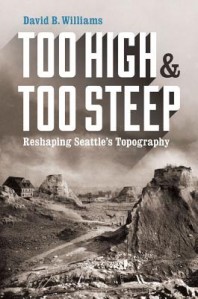 Too High & Too Steep: Reshaping Seattle’s Topography by David B. Williams is an examination of the remarkable things locals have done to transform their city–turning the Duwamish tide flats into dry land, slicing a canal from Puget Sound to Lake Washington, rerouting the Cedar River, and, as mentioned, regrading the hills. Each undertaking was impressive on its own, but collectively they altered our landscape beyond the recognition of the original residents. Even before reading the book, I’d known the general outlines of these projects, but not, you know, their actual outlines. Williams describes those to a tee, with such crystal-clear specificity that you can stand on the precise spots where things changed. In his research he did exactly that, and through his eyes you can see what the old Seattle looked like and what glimpses of it still remain.
Too High & Too Steep: Reshaping Seattle’s Topography by David B. Williams is an examination of the remarkable things locals have done to transform their city–turning the Duwamish tide flats into dry land, slicing a canal from Puget Sound to Lake Washington, rerouting the Cedar River, and, as mentioned, regrading the hills. Each undertaking was impressive on its own, but collectively they altered our landscape beyond the recognition of the original residents. Even before reading the book, I’d known the general outlines of these projects, but not, you know, their actual outlines. Williams describes those to a tee, with such crystal-clear specificity that you can stand on the precise spots where things changed. In his research he did exactly that, and through his eyes you can see what the old Seattle looked like and what glimpses of it still remain.
In addition to where, he also tells exactly when, how, and why the jobs got done, and he does it in an exceptionally concise way. Too High & Too Steep is authoritative and comprehensive enough for any academic, but it’s an engaging and entertaining read for lay audiences. Anyone who’s ever given a moment’s thought to the scenery passing by while strolling a Seattle sidewalk or sailing along its shoreline will find it fascinating. Reading it is practically a civic duty.
David Williams was kind enough to ignore his interviewer’s untempered enthusiasm and answer some questions for our blog.
————————————————-
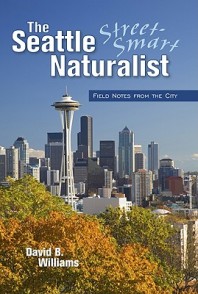 Island Books: In addition to your most recent book, you’re also the author of The Seattle Street-Smart Naturalist, which shows how city-dwellers can and should encounter the natural world, and Cairns, about the simple, ancient constructions that continue to connect people to the landscape. How did you come to specialize in this kind of writing, and what exactly would you call it?
Island Books: In addition to your most recent book, you’re also the author of The Seattle Street-Smart Naturalist, which shows how city-dwellers can and should encounter the natural world, and Cairns, about the simple, ancient constructions that continue to connect people to the landscape. How did you come to specialize in this kind of writing, and what exactly would you call it?
David B. Williams: My writing is an outgrowth of my years teaching about the natural world. I see my books and articles as a way to continue to share the stories that I have learned. I hope that my work will inspire people to go out and take a closer view of the world around them, to ask questions, and to develop a better connection to place. And driving much of my writing is my long term interest in the intersection beween people and the natural world, particularly in the urban landscape. How do we shape it and how does it shape us?
I am not sure what I would call my kind of writing but I like to think of myself as a natural history writer. By this I mean both parts of the phrase. I am interested in nature and in history and try to weave each into my work.
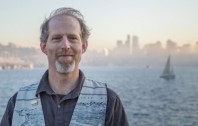
David B. Williams on The Sound
IB: Is your work part of a larger movement of any kind, aesthetic or otherwise? I’m thinking of other writers I see as more or less on the same continuum as you, such as Jack Nisbet, Iain Sinclair, and Geoff Manaugh.
DBW: I am honored to be included in that list. All of us share a deep interest in the place we live, in the stories that are all around us, and in paying attention to the details. We like to ask questions. We like to get out and explore. We want to touch and feel and smell our hometown. We don’t want to just tell stories. We want to make the stories of our place tangible so that others can go out and find connections and develop a deeper relationship to the human and natural world around them.
I don’t think we are alone. There are many other writers exploring similar topics. And it’s not just writers but readers, too. One of the pleasures of writing is having people come up to me and share their discoveries of place. I learn something new at every talk I give.
IB: Is there anything you can tell us about Mercer Island’s geology or the alterations humans have made to its topography? I expect the completion of I-90 had a significant effect on the landscape, for example.
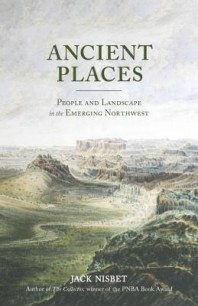
DBW: I have not done much research on Mercer Island so don’t have a very good answer to your question. I do though have a story told to me by Zdenko Frankenberger Danes, a former professor at University of Puget Sound. In 1961, Danes was using a device called a gravimeter to measure gravity on Mercer Island. Although we may think gravity is equal across the planet, it varies based on subsurface geology. Danes found that there was a huge gravity anomaly between the north and south ends of the island. Unfortunately, he was not able to complete his work on the island—because he had borrowed the gravimeter and had to return it—but he eventually got another gravimeter and did more extensive work around Puget Sound. What he discovered was that the anomaly ran across the region. He suspected that there was some kind of fault under the Puget lowland but not until 1990 did other geologists confirm Danes’ hypothesis. We now know it as the Seattle Fault zone, potentially one of the most dangerous geologic features, and it cuts right across the island.
IB: With construction cranes all over the skyline and Bertha inching ponderously along underground, it seems to me that Seattle may right now be undergoing the biggest physical changes it has since the ones you talk about in Too High & Too Steep. Your book seems not only topical, but a bit political. Or am I imagining that?
DBW: Yes and no to your observation and question. We are going through a period of huge change but not the biggest since the ones I discuss. One of the most dramatic alterations to the landscape, and one I would like to know more about, was the construction of the interstates. Both I-5 and I-90 had dramatic impacts on the shape of the land.
One of the points I like to make regarding our present period of change is that it pales in comparison to what happened in the past. For example, if and when Bertha finishes excavating the SR-99 tunnel, she’ll move about 850,000 cubic yards of material. During one three-month period of the Denny regrade, workers moved 900,000 cubic yards and during the period I write about in my book, roughly 1895-1931, more than 75 million cubic yards of sediment were moved.
I think that every generation likes to believe that they are doing something different and new but Seattle has constantly been changing and reinventing itself. It’s just that in the past the changes were much much bigger.
IB: On your blog you have a post about the last vestiges of the days when horses roamed Seattle’s streets, a stepping stone and a hitching post still in place on Capitol Hill. Such things aren’t commercially valuable, but they’re symbols of cultural continuity. In a time when people prefer to experience the world in any way other than actually walking on the earth, do you imagine our city holding onto these items? Is it important to preserve them? Is it possible? If it’s not, how do we best hold onto the knowledge of them?
DBW: Yes, it’s very important to hold onto these items. They keep us connected to place. They reveal our history and how it has influenced us. As I wrote previously, the massive changes in this city are not new. We have been through booms and busts and we can find the evidence all around us, which is one reason we need to preserve it. In response to how we can hold onto the knowledge, get out and explore the world around you on foot, on bike, in a bus, with a book, with a friend, with a guide. There are wonderful stories all around us; all we have to do is slow down, observe, be inquisitive, and get outside.
IB: Have you considered leading tours of the places you discuss?
DBW: I do lead tours and have done so for years. I don’t do it regularly but hope to do more. Also, my next book is a walking guide to Seattle, which incorporates natural and human history in 15 to 20 walks.
IB: Now we know what one diligent writer will be doing in the short term, but what are your predictions for the more distant future of our urban agglomeration? Go ahead and set that scene for us.
DBW: More people. More traffic. More trying to wrestle with our topography. Eventually geology will rear its ugly head and we’ll have a big earthquake or volcanic eruption, which will force us to deal directly with our problematic landscape.
–James Crossley, Island Books, Mercer Island, WA
This interview was originally published on the Island Books blog, Message in a Bottle.


